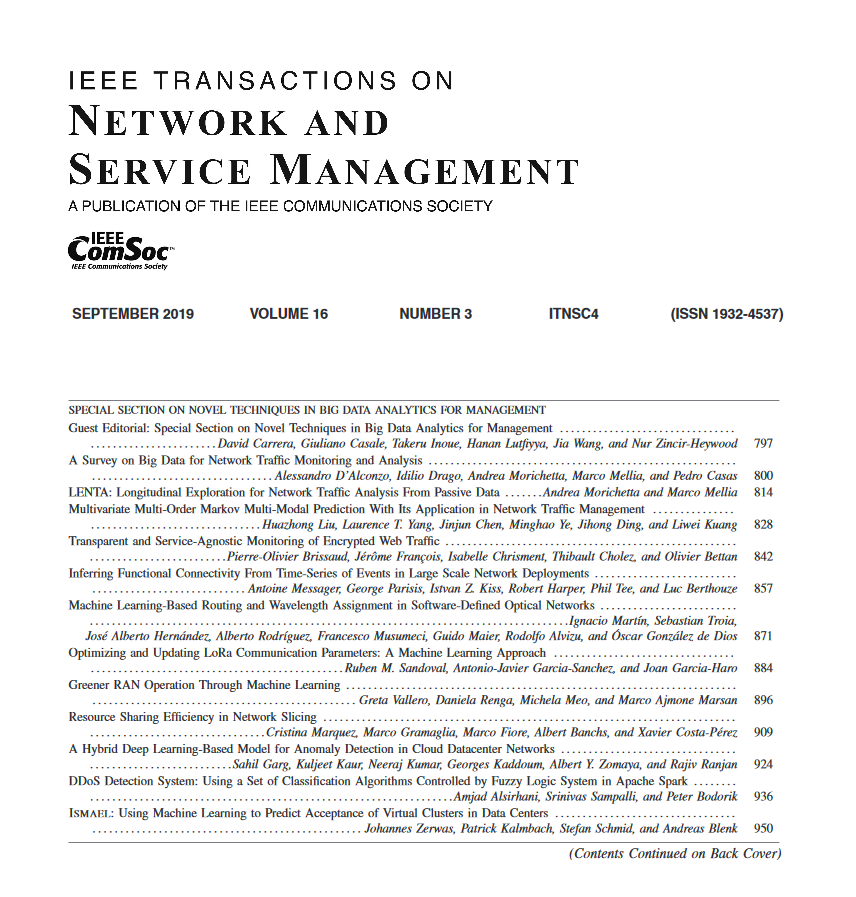Priority-Dominated Traffic Scheduling Enabled ATS in Time-Sensitive Networking
IF 5.4
2区 计算机科学
Q1 COMPUTER SCIENCE, INFORMATION SYSTEMS
IEEE Transactions on Network and Service Management
Pub Date : 2025-01-20
DOI:10.1109/TNSM.2025.3532080
引用次数: 0
Abstract
Time-Sensitive Networking (TSN) employs shaping mechanisms such as Time-Aware Shaping (TAS) and Cyclic Queuing and Forwarding (CQF), which depend heavily on precise time synchronization and complex Gate Control Lists (GCL) configurations, limiting their effectiveness in large-scale mixed traffic networks like those in vehicular systems. In response, IEEE 802.1Qcr protocol introduces the Asynchronous Traffic Shaping (ATS) mechanism, based on Urgency-Based Schedulers (UBS), to asynchronously address diverse traffic needs and ensure low and predictable latency. Nonetheless, no traffic scheduling algorithm exists that can be directly applied to ATS shapers in generic large-scale traffic scenarios to solve for fixed end-to-end (E2E) delay constraints and the number of priority queues.In this paper, we propose an urgency-based fast flow scheduling algorithm (UBFS) to address the issue. UBFS leverages domain-specific optimizing strategies with a focus on traffic delay urgency inspired by greedy algorithm for priority allocation across hops and flows, complemented by preprocessing for scenario solvability and dynamic verification to ensure scheduling feasibility. We benchmark UBFS against the method with both scalability and solution quality in typical network topology and demonstrate that UBFS achieves more rapid scheduling within seconds across linear, ring, and star topologies. Notably, UBFS significantly outperforms the baseline algorithm in scheduling efficiency in mixed and large-scale traffic environments, scheduling a larger number of flows. UBFS also reduces time costs by 2-10 times in delay-sensitive environments and by more than 10 times in large-scale scenarios, effectively balancing time efficiency, performance and scalability, thereby enhancing its applicability in real-world industrial settings.时间敏感型网络中优先级占主导地位的流量调度 ATS
时间敏感网络(TSN)采用诸如时间感知整形(TAS)和循环排队转发(CQF)等整形机制,这些机制严重依赖于精确的时间同步和复杂的门控制列表(GCL)配置,限制了它们在车辆系统等大规模混合交通网络中的有效性。为此,IEEE 802.1Qcr协议引入了基于紧急调度(UBS)的异步流量整形(ATS)机制,以异步处理各种流量需求,并确保低且可预测的延迟。然而,目前还没有一种可以直接应用于ATS整形器的流量调度算法,可以解决固定的端到端(E2E)延迟约束和优先队列数量。本文提出一种基于紧急度的快速流调度算法(UBFS)来解决这一问题。UBFS利用特定领域的优化策略,重点关注由贪婪算法激发的跨跳和流优先级分配的交通延迟紧迫性,并辅以场景可解性预处理和动态验证以确保调度可行性。我们在典型的网络拓扑中对具有可伸缩性和解决方案质量的UBFS进行了基准测试,并证明了UBFS在线性、环状和星形拓扑中实现了更快的调度。值得注意的是,在混合和大规模交通环境下,UBFS的调度效率明显优于基线算法,调度的流量更大。在延迟敏感环境中,UBFS还将时间成本降低了2-10倍,在大规模场景中降低了10倍以上,有效地平衡了时间效率、性能和可扩展性,从而增强了其在现实工业环境中的适用性。
本文章由计算机程序翻译,如有差异,请以英文原文为准。
求助全文
约1分钟内获得全文
求助全文
来源期刊

IEEE Transactions on Network and Service Management
Computer Science-Computer Networks and Communications
CiteScore
9.30
自引率
15.10%
发文量
325
期刊介绍:
IEEE Transactions on Network and Service Management will publish (online only) peerreviewed archival quality papers that advance the state-of-the-art and practical applications of network and service management. Theoretical research contributions (presenting new concepts and techniques) and applied contributions (reporting on experiences and experiments with actual systems) will be encouraged. These transactions will focus on the key technical issues related to: Management Models, Architectures and Frameworks; Service Provisioning, Reliability and Quality Assurance; Management Functions; Enabling Technologies; Information and Communication Models; Policies; Applications and Case Studies; Emerging Technologies and Standards.
 求助内容:
求助内容: 应助结果提醒方式:
应助结果提醒方式:


